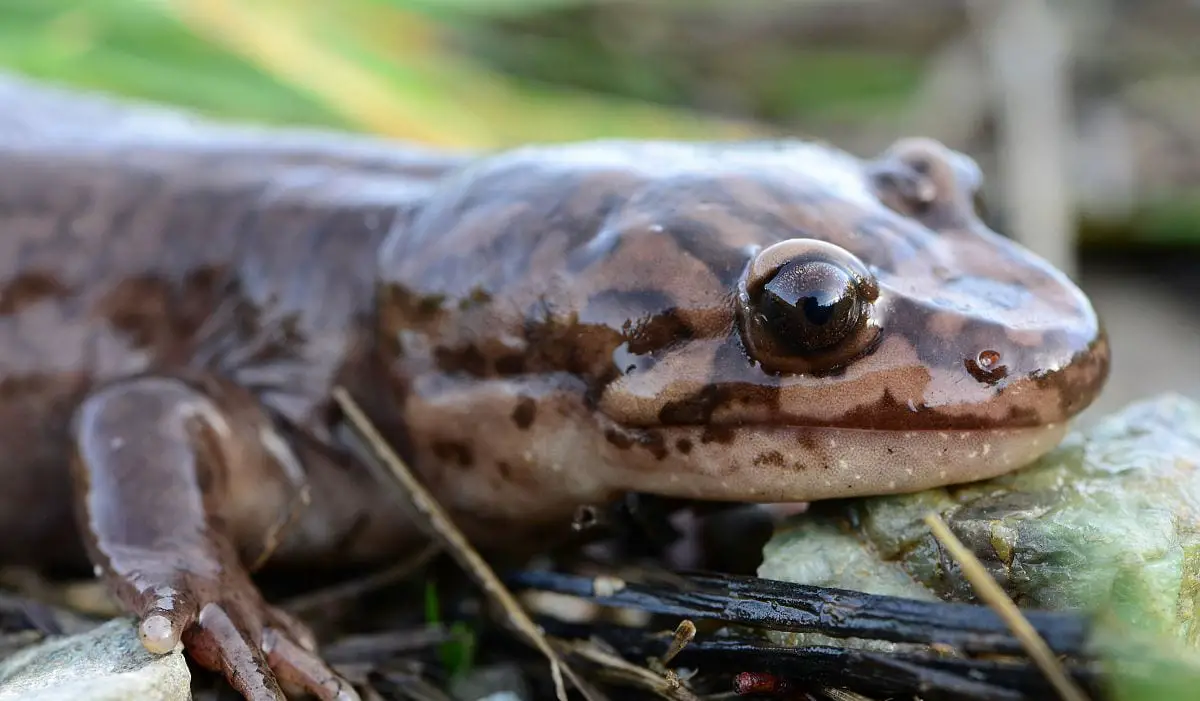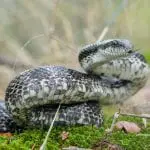Scientific Facts
| Common Name: | Idaho Giant Salamander |
| Scientific Name: | Dicamptodon aterrimus |
| Life Span: | 6 to 10 years |
| Size: | 7 to 13 inches |
| Habitat: | Streams, ponds, and mountain lakes |
| Country of Origin: | Western Montana and Northern Idaho |
Description
The Idaho giant salamander is the type of giant salamanders with the most intricately blotched and darkest skin. It may come in colors purple, brown, grey, tan, and copper-like. Both the Idaho giant salamander and tiger salamander have an apparent resemblance to shape and size. However, the foot tubercles and costal grooves significantly differ between these species.
The Idaho giant salamander has a well-defined body and thick head. Also, it has the 4th toe on the hindfoot having only 3 segments. The adult salamander typically measures 20 centimeters long. However, its size may range from 7 to 11.75 inches, but it extends to approximately 13 inches in some cases.
Tiny exterior gills for minimal stream living can be seen on the larvae. The developing larvae often have a tan body with yellowish blotches through their dermis. They may undergo paedomorphosis, but many of them grow into mature adults.
The Idaho giant salamander is very robust, and its shape resembles the tiger salamander taking steroids. Likewise, the eyes of this lizard are larger than the eyes of a tiger salamander.
The color of an Idaho giant salamander is quite variable as it differs between the paedomorphic and terrestrial adults. The terrestrial adults come with ground colors that can be brown or gray with gorgeous bronze or copper reticulations. Those dorsal colors will fade alongside the sides and will transform into a lighter color ventrally.
The paedomorphic species are generally in dark brown or slate gray at the larval stage, but they maintain this coloration for the rest of their lives. These species may also have pale caramel-colored patterns.
Also, the ventral surfaces for larvae and paedomorphs are either white or light cream, especially in small and younger species. The paedomorphs may grow as big as or bigger than the terrestrial species, but they tend to keep their larval head shapes and gills.
Moreover, these species keep their tail fins that are helping them swim over the swift streams. Flattened heads and low-profile eyes may help them when burrowing, just like how the black, sturdy keratinized pads on the tips of their digits.
Considering their secretive nature, these species spend more time underneath the logs, rocks, and in the aquatic burrows. When they encounter other animals or humans, they can easily swim away for their safety. These animals will quickly disappear by scrambling underneath the boulders and cobbles of the streambed.
Habitat
Larvae normally inhabit clear and cold streams. However, they can also be found living in the ponds and mountain lakes. Adults are found underneath the logs and rocks in the humid forests, beside the mountain streams, and on the rocky shores of the mountainous lakes.
Range
The Idaho giant salamander is more common in the forests of western Montana and northern Idaho. In these wooden regions, this creature lives within the little streams and swampy regions. The adult salamander could be found out of the water beside the streams. It lives underneath the logs and rocks. The aquatic larvae stay in the streams with a height of around 975 m.
Development
The Idaho giant salamander starts to develop right after the mother lays the eggs. When the eggs hatch, the resulting creature moves into the larval phase. The larvae will stay in this phase from 6 to 11 months before it metamorphosizes into an adult and sexually mature Idaho giant salamander. In the wild, the adult salamander can be terrestrial or use the neoteny strategy wherein the adult is aquatic. It has been reported that both kinds of adult Idaho giant salamanders can exist in one location.
The initial couple weeks to approximately 6 months out of the eggs. The mother will supervise the eggs as they hatch. The larvae with exterior gills would be thoroughly aquatic. After this, the young Idaho giant salamander will be on its own. It will take care of its needs – food and shelter. When the process of metamorphosis is over, the larvae will continuously grow until it becomes sexually mature.
Reproduction
The reproduction of the Idaho giant salamander occurs in the spring (May) and fall (October). Breeding is polyandrous, which means both male and female Idaho giant salamanders will mate with different partners throughout their lifetime.
Without the apparent physical differences between males and females, the way of attraction and courtship for these lizards is still a mystery. What only the experts know is that breeding takes place underneath the logs and rocks under the water, and fertilization occurs internally.
When sexually mature, the paedomorphic and terrestrial types of Idaho giant salamanders will mate in the streams. Females will create just one nest for their hatchlings. They deposit the eggs on the base of the submerged stone.
The size of the clutch is projected to range from 135 up to as much as 200 eggs. Just like other amphibians, the eggs are always white and unpigmented. The females stay on the nest to guard the eggs against the predators. Observations on the closely related giant salamander species suggest that upon hatching, the larvae will absorb the yolk before they start feeding on tiny aquatic invertebrates. Small 1st year larvae seem abundant in the headwater springs and seeps, feeding into streams.
Longevity or Life Span
The lifespan of the Idaho giant salamander is still unknown. Some predictions are stating that it can live for 6 to 10 years in the woods. The leading factor that may affect the population of Idaho giant salamanders can be predation. Also, it can be the chytrid fungus called Batrachochytrium dendrobatidis. This species is not popular for keeping as a pet, but it’s always a good choice.
Perception and Communication
Little information is available about the way the Idaho giant salamanders communicate and interact with one other. No one has seen the breeding rituals of these animals – even how the males look for and attract females.
Also, there’s no proof available if they are using pheromones for reproduction or if the males attract the females in any other way. What’s clear is that they use their vision to perceive the environment.
Like other salamander species, the Idaho giant salamander can “hear” even if they don’t have ears as they depend on the vibrations in the environment. It can also be vocal though it happens only in some cases. When it feels threatened, the Idaho giant salamander may make a squawking or barking noise to discourage the predators.
Food Habits
This giant salamander is an omnivore. It can eat tiny insects like mayflies. It can also eat arachnids, small mammals, young snakes, and tiny branches of plants or any other shrubs. Likewise, the Idaho giant salamander may even eat the little tadpoles that are part of its family.
The kind of food it consumes will depend on the lizard’s size and phase of life. If it’s a smaller, younger salamander, then it will feed on smaller plants and insects. Of course, the adult Idaho giant salamander will eat larger insects, arachnids, and other larval species. It can also eat snails.
Mating
The mating process for Idaho giant salamander may take place in May and October. Because of the females’ prolonged investment in their eggs and larvae will just alternate its reproduction time every year while the male may reproduce the time of the year. After breeding, the females will lay between 130 to 200 eggs. They lay the eggs deep into the water inside the little pool underneath the rocks or submerged logs.
The eggs will hatch in the next 6 to 7 months. Once the eggs hatched, the larva will take 3 to 6 months to learn how to be independent. At this period, the females are still present to watch over and protect the larva from the possible predators.
The process of metamorphosis for both male and female Idaho giant salamanders take around 1 to 2 years to complete. They stay immature until the age of 2. They are ready to mate and reproduce at the age of 3 to 5. No information about the birth mass of these lizards is available.
After they lay the eggs, the mothers will stay in the nest together with the larva and some male salamanders. The females need to keep an eye not just on the other animals but even to males of their family. This is true because the male Idaho giant salamanders have the so-called cannibalistic tendency, which means they eat those unattended eggs. The females remain with their hatchlings until the next 3 to 4 months after the eggs hatched.
Predation and Behavior
To prevent predation, the Idaho giant salamander has extremely slimy skin, which prevents predators from gripping firmly on their bodies. This oily layer also comes with a harmful substance, which can be too dangerous for the predators if they ingest it. This giant salamander is also capable of biting any animal that is threatening it. In certain cases, some species of this kind seen making a sound that helps them ward off the predators.
The possible predators of Idaho giant salamander are the freshwater fish and the common garter snake (Thamnophis sirtalis). Also, they can be eaten by small mammals like the members of the weasel family, including the water shrew.
Its Role in the Ecosystem
This giant salamander species has a very crucial role within the moderate forest ecosystem. It possibly contributes to local pest population control by using them as predators for these insects. Likewise, the Idaho giant salamander becomes prey to smaller mammals and reptiles like the garter snakes and water shrews.
Availability – Where to Get One?
If you want to keep an Idaho giant salamander, then you may look for this species at the local pet stores and breeders. Getting it may be much easier and convenient from the pet stores on the web.
How to Care for an Idaho Giant Salamander?
First of all, your pet needs an aquarium. A 60-gallon aquarium that contains water of 8-10 inches deep will be good enough for this species. Also, provide your pet with an overhanging bank that is at least 3 feet long and 3 feet wide.
A water bowl is necessary, too. Make some holes on its base to allow the water to drain going to the ground. When creating a captive habitat for an Idaho giant salamander, always try to make the whole thing natural-looking. Build it based on the original habitat of the species in the forest. Add some rocks with crevices that will serve as hiding spots for the animal.
For the temperature, it should remain at around 55 degrees Fahrenheit. The wire-screen cover is a good addition that you can use in keeping your pet inside the cage. Plexiglas placed on the top of the aquarium will help in maintaining the humidity level at the ideal range.
Compact fluorescent lamps or full-spectrum lights will keep the moss, ivy, and water plants healthy and green. Replace the evaporating water with distilled water. You can also use distilled water to clean the glass. Filter media and incomplete water changes are made for some cases to reduce waste buildup.
FAQs
Are Idaho Giant Salamanders poisonous?
The Idaho Giant Salamanders can be poisonous not just to other animals but even to humans. They excrete a toxic secretion through their skin, making them poisonous.
Where do Idaho Giant Salamanders live?
Adult Idaho Giant Salamanders live under the rocks and logs found in the humid forests, close to mountain streams, and rocky shores of the mountain lakes. Larva stays in the water until metamorphosis.
How long do Idaho Giant Salamanders live?
Unlike other salamanders, the Idaho Giant Salamanders seem to live a bit shorter. Many of them reach 6 to 10 years.
What is the scientific name of the Idaho Giant Salamander?
The common name of this species is Idaho giant salamander. Its scientific name is Dicamptodon aterrimus.
Are Idaho Giant Salamanders good pets?
The Idaho Giant Salamanders may not be friendly at first. Eventually, they become docile and responsive to handling with proper handling and regular interaction with humans.



